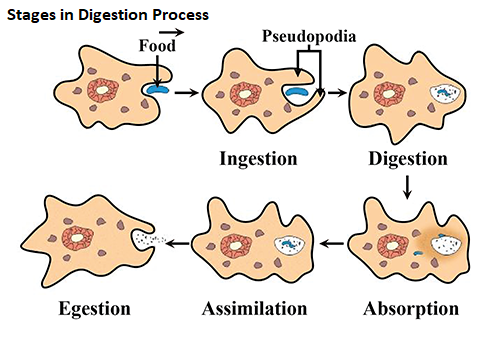
An amoeba is a unicellular animal, which doesn’t have a stomach for digestion of food. How does food storage and digestion take place in an amoeba?
Answer
369.3k+ views
Hint: Amoeba is a single-celled organism, which can alter its shape through the extension and retraction of pseudopodia. Since there is no stomach present in the amoeba, storage of food and digestion takes place inside the food vacuole in the cytoplasm of the amoeba. Once the food is digested, it finally reaches the cell organelle. Gastric vacuoles and enzymatic digestion aid in the digestive process of the amoeba.
Complete answer:

Fig: Food Storage and Digestive Process in Amoeba
> Amoebae surround themselves with temporary extensions called pseudopodia. They enrich the food particles and engulf them.
> They meet across food particles forming a food vacuole or gastric vacuole, with the smaller part of the cytoplasm and cell membrane.
> Through cytoplasmic movements, the vacuole is pushed deeper, where it fuses with lysosomes.
> Lysosomes are the organelles containing digestive enzymes like proteinase and amylase, which digest proteins and carbohydrates respectively. Fats are not usually digested by amoeba.
> Food vacuole consists of all the essential enzymes, which break down the complex food molecules into simpler and smaller units.
> The absorbed nutrients are circulated to all the parts of the amoeba via cytoplasmic movements. Via a simple diffusion process, the digested food is absorbed in the cytoplasm. If there is any excess food, the amoeba stores it in the cytoplasm in the form of glycogen and lipids.
> The absorbed nutrients are useful in energy production, which is essential in growth, locomotion, reproduction, and repair.
> The residual waste matter is excreted via a temporary opening at the nearest point.It happens when a sufficient amount of waste is collected and occurs through the rupture and integration of the cell membrane.
Note:
Some amoebae are predatory, consuming bacteria and other protists. Some of them are detritivores, eating dead organic matter. Thus, the food source of amoeba varies. Amoeba ingests the food via the process of phagocytosis. It does not possess a mouth and there is no specific place in the cell at which phagocytosis usually takes place. A few amoeba ingest food through the endocytosis process, imbibing the dissolved nutrients via vesicles formed inside the cell membrane
Complete answer:

Fig: Food Storage and Digestive Process in Amoeba
> Amoebae surround themselves with temporary extensions called pseudopodia. They enrich the food particles and engulf them.
> They meet across food particles forming a food vacuole or gastric vacuole, with the smaller part of the cytoplasm and cell membrane.
> Through cytoplasmic movements, the vacuole is pushed deeper, where it fuses with lysosomes.
> Lysosomes are the organelles containing digestive enzymes like proteinase and amylase, which digest proteins and carbohydrates respectively. Fats are not usually digested by amoeba.
> Food vacuole consists of all the essential enzymes, which break down the complex food molecules into simpler and smaller units.
> The absorbed nutrients are circulated to all the parts of the amoeba via cytoplasmic movements. Via a simple diffusion process, the digested food is absorbed in the cytoplasm. If there is any excess food, the amoeba stores it in the cytoplasm in the form of glycogen and lipids.
> The absorbed nutrients are useful in energy production, which is essential in growth, locomotion, reproduction, and repair.
> The residual waste matter is excreted via a temporary opening at the nearest point.It happens when a sufficient amount of waste is collected and occurs through the rupture and integration of the cell membrane.
Note:
Some amoebae are predatory, consuming bacteria and other protists. Some of them are detritivores, eating dead organic matter. Thus, the food source of amoeba varies. Amoeba ingests the food via the process of phagocytosis. It does not possess a mouth and there is no specific place in the cell at which phagocytosis usually takes place. A few amoeba ingest food through the endocytosis process, imbibing the dissolved nutrients via vesicles formed inside the cell membrane
Recently Updated Pages
Master Class 9 General Knowledge: Engaging Questions & Answers for Success

Master Class 9 English: Engaging Questions & Answers for Success

Master Class 9 Science: Engaging Questions & Answers for Success

Master Class 9 Social Science: Engaging Questions & Answers for Success

Master Class 9 Maths: Engaging Questions & Answers for Success

Class 9 Question and Answer - Your Ultimate Solutions Guide

Trending doubts
Fill the blanks with the suitable prepositions 1 The class 9 english CBSE

How do you graph the function fx 4x class 9 maths CBSE

Difference Between Plant Cell and Animal Cell

What is pollution? How many types of pollution? Define it

Voters list is known as A Ticket B Nomination form class 9 social science CBSE

Which places in India experience sunrise first and class 9 social science CBSE




